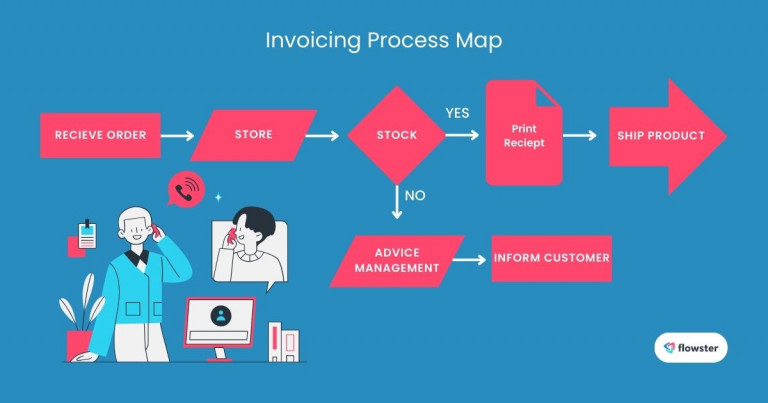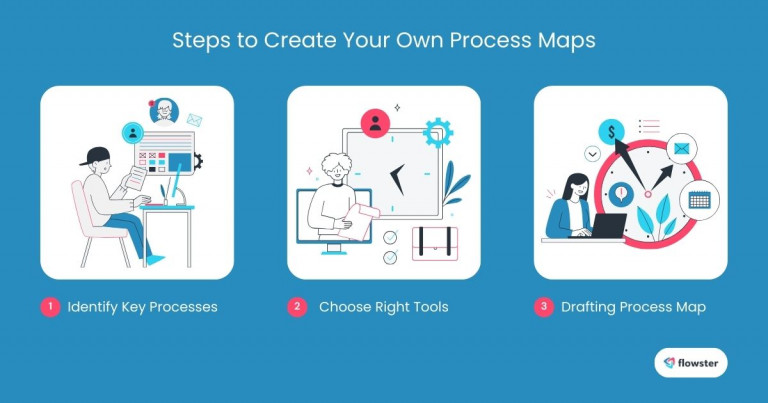As a small business owner or solopreneur, you’ve likely experienced the overwhelming feeling of juggling countless tasks. From client projects to administrative duties, it can be challenging to keep track of everything and ensure smooth operations. This is where process mapping in task management comes into play.
Process mapping is a visual technique that helps you break down complex processes into simpler steps. By mapping out your workflows, you gain a clearer understanding of how tasks are interconnected and identify potential bottlenecks or inefficiencies. This powerful tool can revolutionize your approach to task management, leading to increased productivity and streamlined operations.
Article Outline
What is Process Mapping?
Process mapping is a visual technique that helps you break down complex processes into simpler steps. By mapping out your workflows, you gain a clearer understanding of how tasks are interconnected and identify potential bottlenecks or inefficiencies.
Components of a Process Map
A process map typically consists of the following elements:
- Nodes: These represent specific tasks or activities within a process.
- Arrows: These indicate the flow of the process, showing the sequence of steps.
- Symbols: These can be used to represent different types of activities, such as decision points, delays, or inspections.
Real-World Examples of Process Mapping
To illustrate the practical application of process mapping, let’s consider two common business scenarios:
- Invoicing Process: By mapping out the invoicing process, you can identify potential delays, such as waiting for approval or data entry errors.
- Customer Onboarding: A process map can help streamline the customer onboarding process by highlighting areas where automation or simplification can improve efficiency.
By understanding the fundamentals of process mapping and its components, you can effectively apply this technique to enhance your task management strategies. In the next section, we’ll delve into the reasons why process mapping is crucial for efficient task management.

Why Process Mapping Matters in Task Management
Process mapping is not just a theoretical concept; it’s a practical tool that can significantly impact your task management efficiency. Let’s explore the key benefits:
Visualizing Workflows
- Clarity and Understanding: Visual representations, such as flowcharts and swimlane diagrams, make complex processes easier to understand. By breaking down intricate workflows into simpler steps, you can gain a clearer perspective on the overall process.
- Identifying Bottlenecks: Process mapping helps you pinpoint areas where tasks are delayed or where resources are underutilized. By identifying these bottlenecks, you can take steps to optimize your workflow and improve efficiency.
Process mapping helps you pinpoint areas where tasks are delayed or where resources are underutilized. By identifying these bottlenecks, you can take steps to optimize your workflow and improve efficiency. For a more in-depth exploration of eliminating workflow bottlenecks, check out this helpful article from Flowster: Link to Flowster article.
Enhancing Collaboration
- Team Alignment: A shared process map can serve as a common reference point for team members, ensuring everyone is aligned on the goals, steps, and responsibilities.
- Facilitating Communication: Clear and concise process maps minimize misunderstandings and facilitate effective communication among team members.
Clear and concise process maps minimize misunderstandings and facilitate effective communication among team members. Process mapping can also serve as a foundation for workflow automation, which further streamlines collaboration and boosts productivity. To learn more about the benefits of workflow automation, check out this insightful article from Flowster: Link to Flowster article.
Boosting Productivity
- Clear Task Delineation: By defining specific tasks and their sequence, process mapping helps you allocate resources efficiently and avoid overlapping responsibilities.
- Streamlined Operations: Well-defined processes can lead to faster turnaround times, reduced errors, and improved overall productivity.
By understanding the fundamentals of process mapping and its components, you can effectively apply this technique to overcome inefficient processes. Flowster offers a great resource that dives deeper into overcoming inefficiencies: Link to Flowster article.
Capture Your Processes in Minutes!
Steps to Create Your Own Process Maps
Now that you understand the benefits of process mapping, let’s dive into the steps to create your own.
Identify Key Processes
The first step is to identify the core processes within your business. This could include anything from customer onboarding to product development. A brainstorming session can help you list out all the key processes that you want to map.
However, choosing the wrong processes can hinder the effectiveness of your maps. To ensure you’re focusing on the right areas, be sure to avoid these common mistakes in identifying critical processes: Link to Flowster article.
Choose the Right Tools
To create effective process maps, you can use various tools, both digital and analog. Some popular digital tools include:
- Flowster: A user-friendly tool specifically designed for process mapping and automation.
- Microsoft Visio: A versatile diagramming tool that can be used to create detailed process maps.
- Lucidchart: A cloud-based diagramming tool that offers a wide range of templates and features.

Drafting the Process Map
Once you’ve chosen your tool, you can start drafting your process map. Follow these steps:
- Define the Scope: Determine the beginning and end points of the process you’re mapping.
- Identify the Steps: Break down the process into smaller, manageable steps.
- Map the Flow: Use arrows to indicate the sequence of steps.
- Add Symbols: Utilize symbols to represent different activities, such as decision points, delays, or inspections.
Tips for Effective Mapping:
- Involve Your Team: Collaborate with your team members to gain diverse perspectives and ensure accuracy.
- Keep it Simple: Avoid overcomplicating your process maps. Focus on the essential steps and avoid unnecessary details.
- Review and Refine: Regularly review your process maps to identify areas for improvement and make necessary adjustments.
Once you’ve chosen your tool, you can start drafting your process map. Follow these steps to get started. For a comprehensive guide on creating effective process maps, including best practices and additional tips, refer to this insightful resource from Asana: Link to Asana article.
Success Story: Jason Egan’s Process Mapping Transformation
In this video, Jason Egan shares how using Flowster to implement process mapping transformed his business. He highlights the shift from inefficiencies and unclear tasks to streamlined operations and measurable success. This real-life example demonstrates how structured workflows can significantly boost productivity and accountability
Conclusion: Elevate Your Task Management with Process Mapping
Process mapping in task management is a powerful tool that can transform your business operations. By visualizing workflows, identifying bottlenecks, and streamlining processes, you can significantly improve efficiency and productivity.
Don’t wait any longer to harness the power of process mapping. Start by identifying key processes within your business and choosing a suitable tool to create your maps. Remember, even simple process maps can yield significant benefits.
To get started, explore the wealth of free workflow templates available on the Flowster Marketplace. These templates can serve as a foundation for your own process maps, saving you time and effort.
By taking the initiative to implement process mapping, you’ll be well on your way to achieving greater efficiency, better collaboration, and overall business success.




